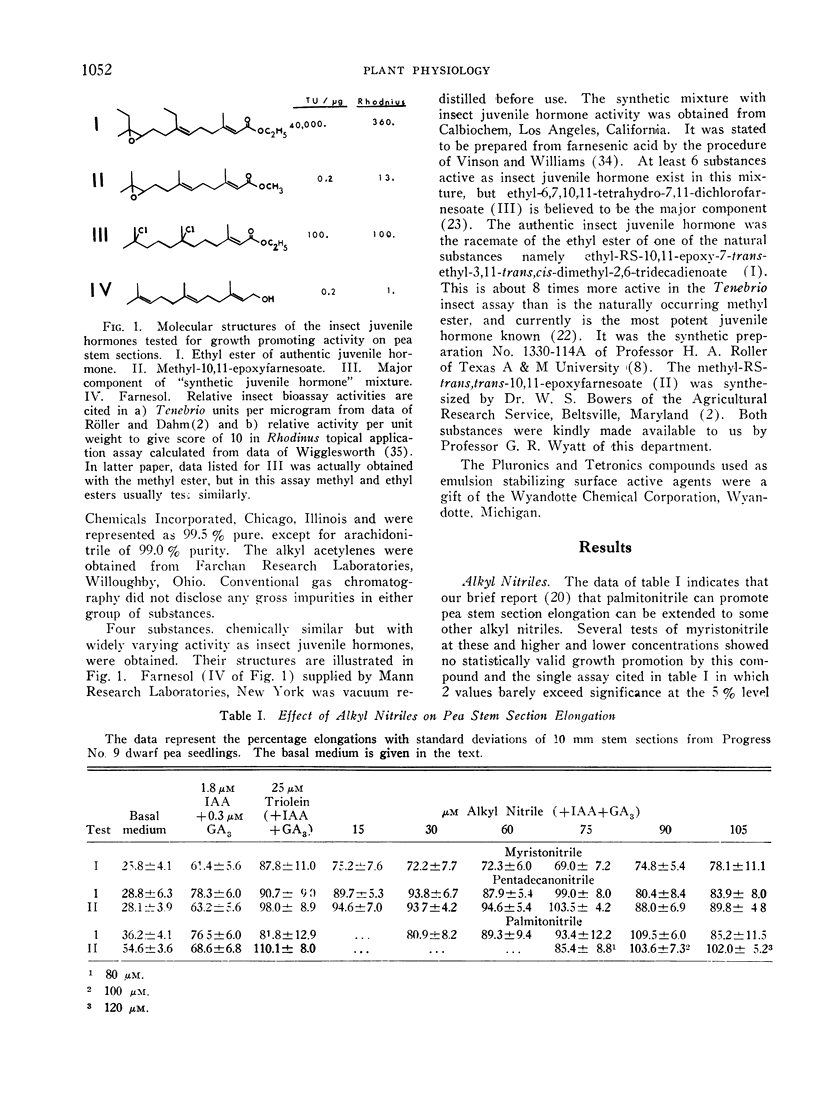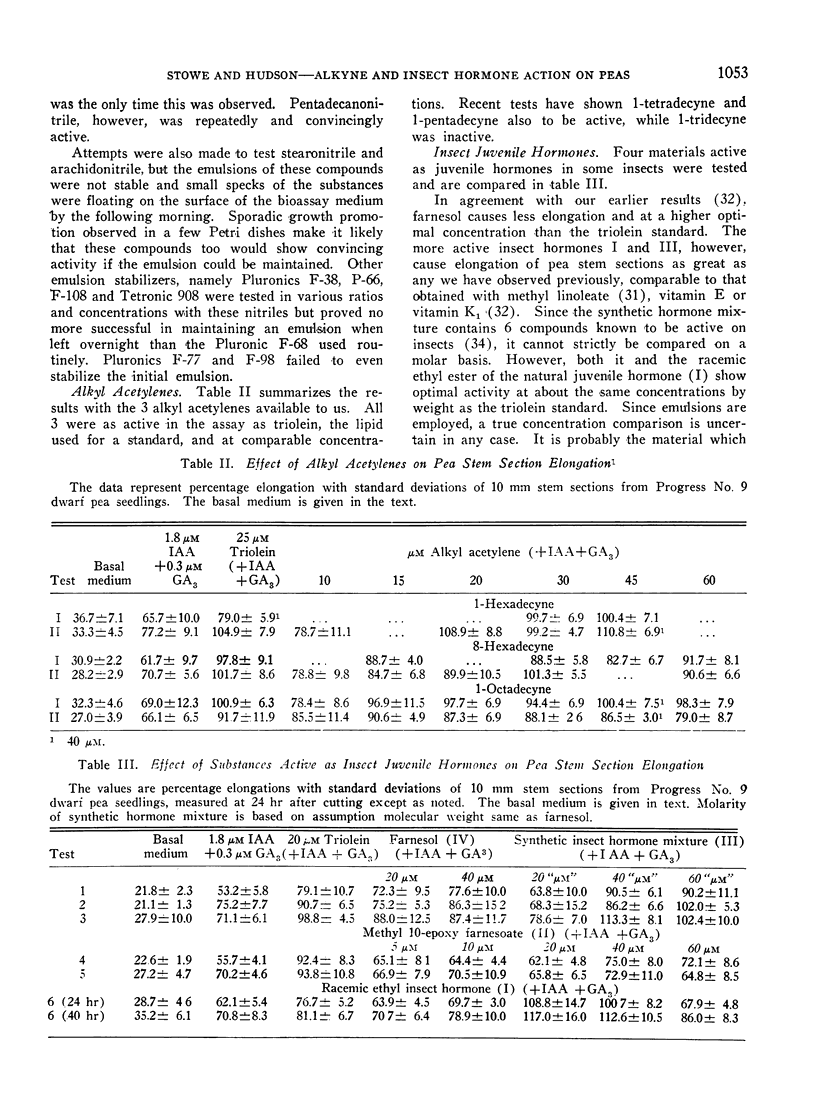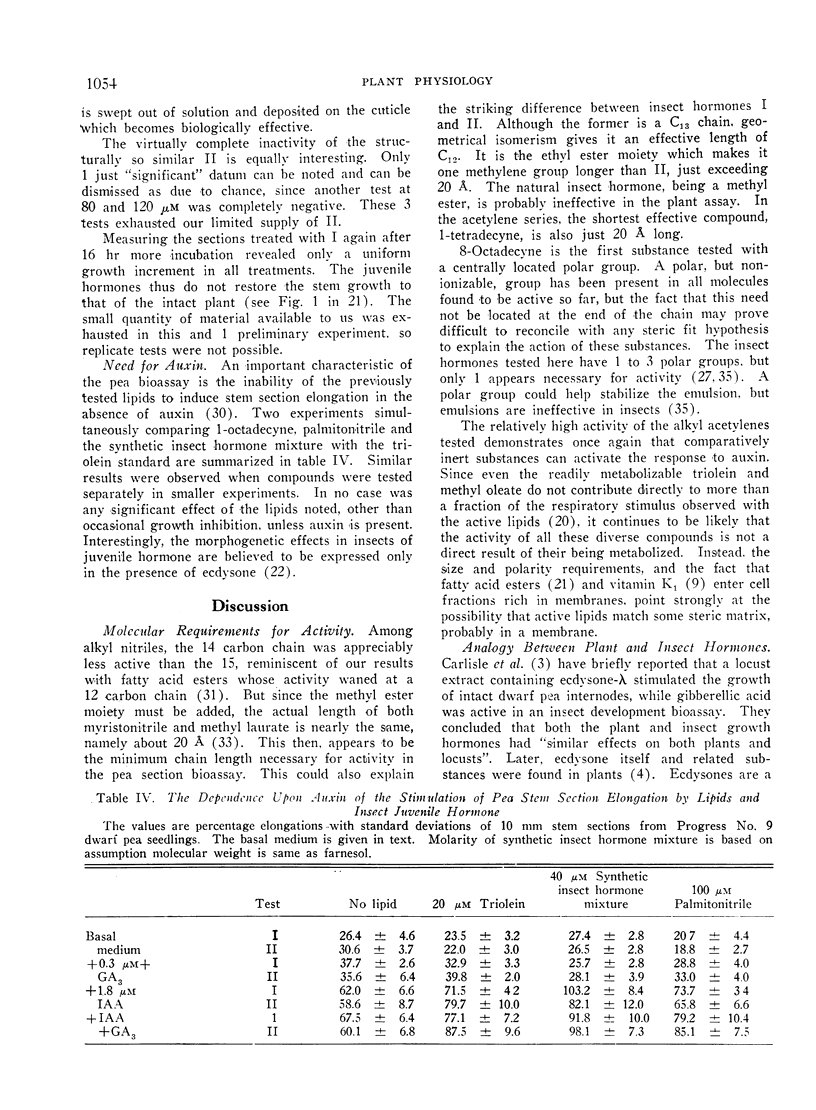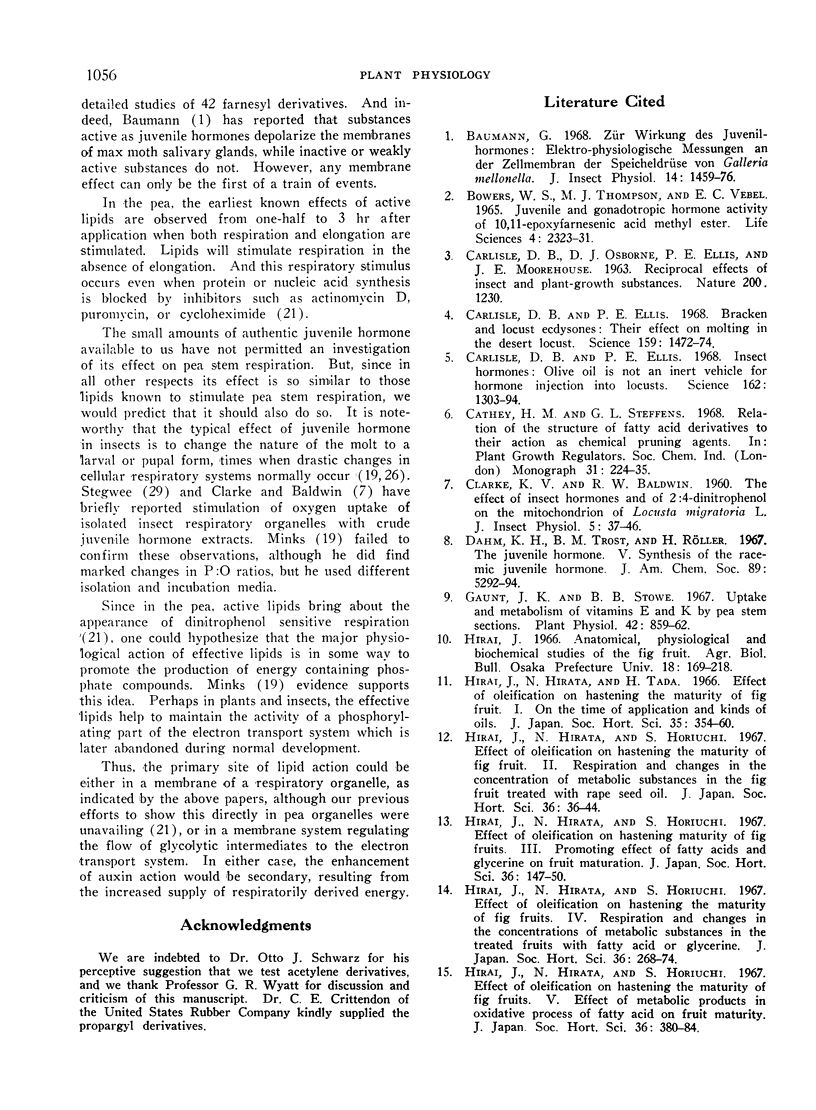Abstract
C14, C15, and C16 alkyl nitriles, and C16 and C18 alkyl acetylenes at 10 to 105 micromolar concentrations promote the growth of stem sections from red-light-exposed seedlings of dwarf peas (Pisum sativum L. cv. Progress No. 9). Similar results were obtained with substances active as insect juvenile hormones, namely farnesol, the racemic ethyl ester of 1 of the natural hormones, and a “synthetic juvenile hormone” mixture, the latter 2 having as high an activity in the pea assay as any lipid reported previously. A sterically nearly identical compound, methyl-RS-10,11-epoxyfarnesoate, is a weak insect hormone and did not promote plant growth. Thus activity in peas and in insects is in some cases parallel. Other similarities and some differences are discussed. Peas appear to require molecules longer than 20A, while insect activity is maximal at that length. All active molecules are ineffective in promoting pea stem elongation by themselves, indole acetic acid must also be present. The lipid effect in plants and the juvenile hormone response in insects have much in common and the evidence suggests they could have a similar locus of action in a membrane controlling respiratory function.
Full text
PDF






Selected References
These references are in PubMed. This may not be the complete list of references from this article.
- Bowers W. S., Thompson M. J., Uebel E. C. Juvenile and gonadotropic hormone activity of 10,11-epoxyfarnesenic acid methyl ester. Life Sci. 1965 Dec;4(23):2323–2331. doi: 10.1016/0024-3205(65)90256-0. [DOI] [PubMed] [Google Scholar]
- CARLISLE D. B., OSBORNE D. J., ELLIS P. E., MOORHOUSE J. E. RECIPROCAL EFFECTS OF INSECT AND PLANT-GROWTH SUBSTANCES. Nature. 1963 Dec 21;200:1230–1230. doi: 10.1038/2001230a0. [DOI] [PubMed] [Google Scholar]
- Carlisle D. B., Ellis P. E. Bracken and locust ecdysones: their effects on molting in the desert locust. Science. 1968 Mar 29;159(3822):1472–1474. doi: 10.1126/science.159.3822.1472. [DOI] [PubMed] [Google Scholar]
- Gaunt J. K., Stowe B. B. Uptake and metabolism of vitamins e and k by pea stem sections. Plant Physiol. 1967 Jun;42(6):859–862. doi: 10.1104/pp.42.6.859. [DOI] [PMC free article] [PubMed] [Google Scholar]
- Hearst E. Discrimination learning as the summation of excitation and inhibition. Science. 1968 Dec 13;162(3859):1303–1306. doi: 10.1126/science.162.3859.1303. [DOI] [PubMed] [Google Scholar]
- Kende H., Lang A. Gibberellins and Light Inhibition of Stem Growth in Peas. Plant Physiol. 1964 May;39(3):435–440. doi: 10.1104/pp.39.3.435. [DOI] [PMC free article] [PubMed] [Google Scholar]
- Meyer A. S., Schneiderman H. A., Hanzmann E., Ko J. H. The two juvenile hormones from the cecropia silk moth. Proc Natl Acad Sci U S A. 1968 Jul;60(3):853–860. doi: 10.1073/pnas.60.3.853. [DOI] [PMC free article] [PubMed] [Google Scholar]
- Penny D., Stowe B. B. Relationship between growth and respiration induced by lipids in pea stem sections. Plant Physiol. 1965 Nov;40(6):1140–1145. doi: 10.1104/pp.40.6.1140. [DOI] [PMC free article] [PubMed] [Google Scholar]
- Penny D., Stowe B. B. Relationship of lipid metabolism to the respiration and growth of pea stem sections. Plant Physiol. 1966 Feb;41(2):360–365. doi: 10.1104/pp.41.2.360. [DOI] [PMC free article] [PubMed] [Google Scholar]
- Romanuk M., Sláma K., Sorm F. Constitution of a compound with a pronounced juvenile hormone activity. Proc Natl Acad Sci U S A. 1967 Feb;57(2):349–352. doi: 10.1073/pnas.57.2.349. [DOI] [PMC free article] [PubMed] [Google Scholar]
- Röller H., Dahm K. H. The chemistry and biology of juvenile hormone. Recent Prog Horm Res. 1968;24:651–680. doi: 10.1016/b978-1-4831-9827-9.50018-6. [DOI] [PubMed] [Google Scholar]
- SCHNEIDERMAN H. A., GILBERT L. I. CONTROL OF GROWTH AND DEVELOPMENT IN INSECTS. Science. 1964 Jan 24;143(3604):325–333. doi: 10.1126/science.143.3604.325. [DOI] [PubMed] [Google Scholar]
- SCHNEIDERMAN H. A., GILBERT L. I., WEINSTEIN M. J. Juvenile hormone activity in microorganisms and plants. Nature. 1960 Dec 17;188:1041–1042. doi: 10.1038/1881041a0. [DOI] [PubMed] [Google Scholar]
- Schneiderman H. A., Krishnakumaran A., Kulkarni V. G., Friedman L. Juvenile hormone activity of structurally unrelated compounds. J Insect Physiol. 1965 Dec;11(12):1641–1649. doi: 10.1016/0022-1910(65)90031-4. [DOI] [PubMed] [Google Scholar]
- Stowe B. B. Growth Promotion in Pea Stem Sections. I. Stimulation of Auxin and Gibberellin Action by Alkyl Lipids. Plant Physiol. 1960 Mar;35(2):262–269. doi: 10.1104/pp.35.2.262. [DOI] [PMC free article] [PubMed] [Google Scholar]
- Stowe B. B., Obreiter J. B. Growth Promotion in Pea Stem Sections. II. By Natural Oils & Isoprenoid Vitamins. Plant Physiol. 1962 Mar;37(2):158–164. doi: 10.1104/pp.37.2.158. [DOI] [PMC free article] [PubMed] [Google Scholar]
- Vinson J. W., Williams C. M. Lethal effects of synthetic juvenile hormone on the human body louse. Proc Natl Acad Sci U S A. 1967 Jul;58(1):294–297. doi: 10.1073/pnas.58.1.294. [DOI] [PMC free article] [PubMed] [Google Scholar]


